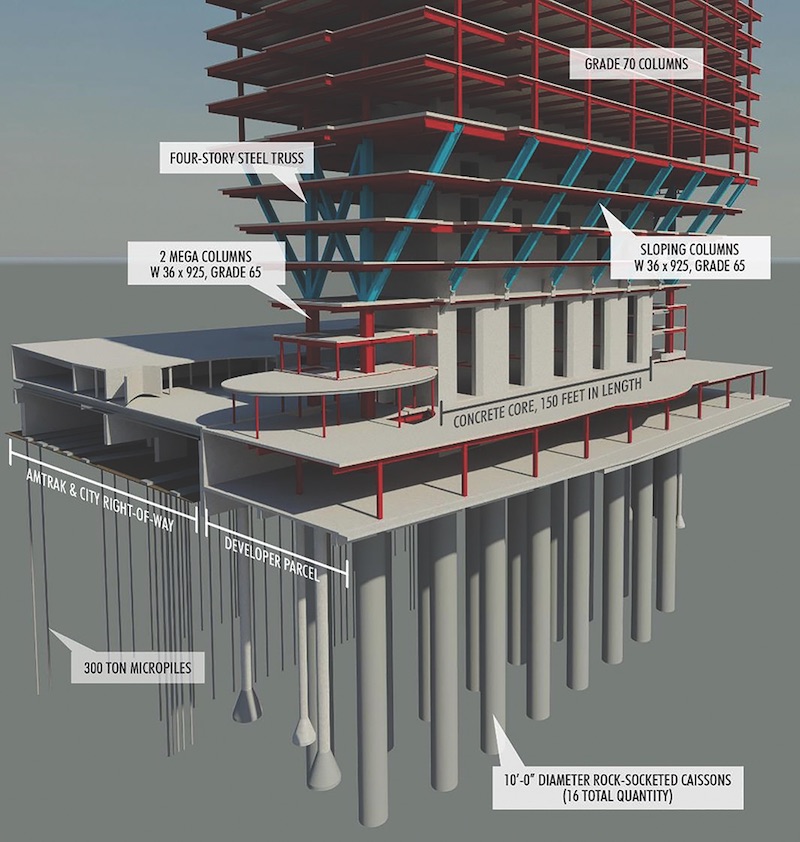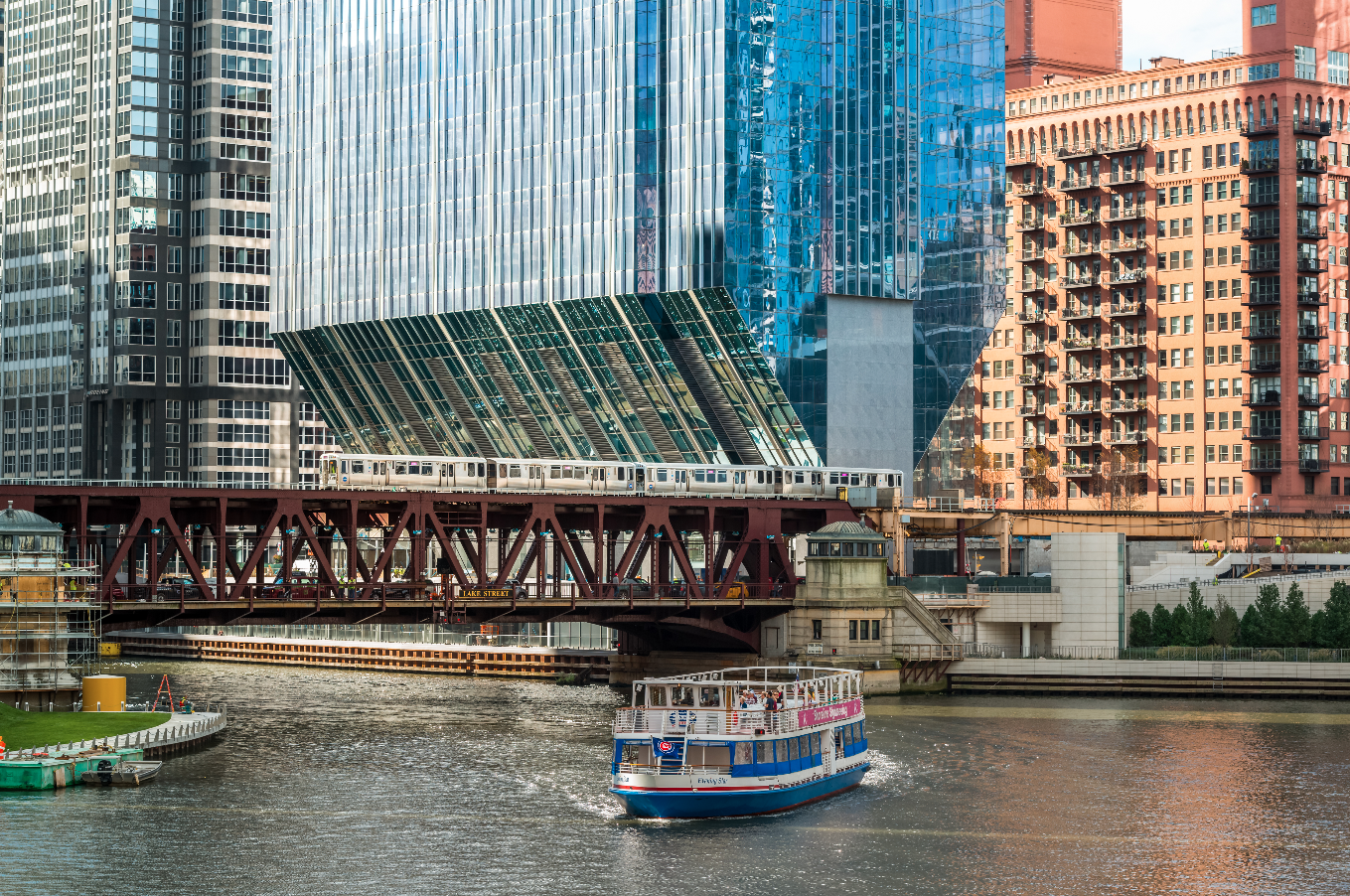The Pencil Building. That’s what passersby already are calling 150 North Riverside, the recently opened 54-story office building along the river in downtown Chicago.
No wonder. Viewed from the north or south, its silhouette resembles a giant stylus stabbed into a tight urban plot. That the structure can balance such height and mass on a pinpoint, 39-foot-wide base defies the imagination.
That 150 North Riverside managed to get built at all, despite technical constraints that scared off lesser mortals for nearly a century, is testament to the gumption of the developer, Riverside Investment & Development, and its Building Team, led by Clark Construction Group, architect Goettsch Partners, and structural engineer Magnusson Klemencic Associates (MKA).
The judges for the Building Team Awards were so impressed with the team’s determination to beat the odds that they unanimously honored 150 North Riverside with this year’s only Platinum Award.
Let’s take a look at what made this project so outstanding, starting with the site itself.
 The gigantic crane worked from a barge in the river. Photo: Andrew Bruah.
The gigantic crane worked from a barge in the river. Photo: Andrew Bruah.
NOT MUCH ROOM TO WORK IN
Five and a half years ago, after retiring as president of the John Buck Company, John O’Donnell, CEO of the then newly formed Riverside Investment & Development, acquired this two-acre parcel. The site, which O’Donnell had been eyeing for years, was flanked on the east by the Chicago River and on the west by seven active Amtrak rail tracks that consumed two-thirds of the acreage. That left a sliver 85 feet wide to build on. But not so fast! The city snatched a 30-foot slice to add another leg to the ever-lengthening Chicago Riverwalk, and O’Donnell mandated a 45-foot minimum lease span. What remained was a 40-foot-wide swath to accommodate a 6,318-sf base.
'We had a convergence of technical expertise that made the going-in risk more palatable.'
— Tony Scacco, Riverside Investment & Development
To gain elbowroom in which to work, the team proposed building a 1½-acre “bridge,” or deck, over the tracks. Ordinarily, belled caissons would have provided sufficient structural support for such a deck. But general contractor Clark Construction knew from its work on a nearby job that digging belled caissons can produce a lot of messy spoils that must be removed; they also require a big rig that takes time to demobilize. Since the pile driving could only be done from 1:00 to 5:00 a.m. to avoid clashing with Amtrak service, belled caissons were ruled out as a structural option.
MKA and geotechnical consultant GEI redesigned the foundations to a 9½-inch-diameter “micropile” system. This allowed Clark Construction to use a smaller rig that produced no spoils and could be maneuvered in and out of the rail yard quickly. But they also knew they had to limit the total number of piles, which meant the piles had to be as strong as possible. “We started with 400-kip micropiles, but GEI said the fewer times we had to dig, the better, so we kept going up in strength,” said MKA’s Robert Chmielowski, PE, SE.
In the course of about four months, Clark Construction sank over a hundred 600-kip micropiles—the highest-capacity piles ever installed in Chicago—between the tracks. “In terms of strength, 600-kip is off the charts,” said Chmielowski. For the tower foundation, MKA designed 16 fully reinforced caissons, each 10 feet in diameter, which were drilled six feet into bedrock. The team also pre-planned the foundation reinforcement design so that a floor could be added to the building midway through construction at the developer’s request.
The street-level bridge enabled Clark Construction to bring in upgraded utility service and to drive heavy equipment onto the site, which sped up the work. As for Amtrak service, “We had zero interruptions,” said Clark Construction’s Project Executive, Chris Phares, PE.
That took care of the Amtrak portion of the project. Dealing with the riverside edge of the site became a whole new exercise in problem solving.
 An elaborate micropile, caisson, and steel framework supports the tower. Magnusson Klemencic Associates.
An elaborate micropile, caisson, and steel framework supports the tower. Magnusson Klemencic Associates.
BUILDING ON EARNED KNOWLEDGE
Both Goettsch Partners and MKA had designed buildings that flared up from a narrow pedestal: Goettsch, in its design for Sowwah Square, Abu Dhabi; MKA, in its work on Rainier Tower, Seattle. In consultation with Clark Construction and GEI, they put this experience to work to create the sloping four-story steel trusses that support the 28,000-sf floor plates in the tower.
Once again, space was at a premium. Amtrak insisted that the erector’s crane had to be capable of hoisting 150% of the load—130,000 pounds of precast concrete bridge girders at a time—at a distance of 225 feet from center. There was no way a crane of that size could maneuver in the limited space available.
So the Building Team looked eastward for inspiration. “We decided to view the river not as a liability, but as an asset,” said Phares. “We said, Let’s put the crane on the river, and let’s make it the biggest crane possible.”
That’s what they did. Clark Construction tied 31 Poseidon barges together to form a floating platform. On it they mounted a two-million-pound Manitowoc 888 Ringer crane capable of lifting 1.3 million pounds at a time.
“We pieced together the biggest pieces that could be driven over the road, 60,000 pounds each, and put them together on site like an Erector Set, sometimes into quarter-million-pound assemblies,” said Phares. Using the gigantic Ringer, the erector, Chicago Steel Construction, was easily able to lift the huge trusses into position. “We drew particularly large crowds on the street and on the bridges when we did that,” said Phares.
‘the Riverwalk we created has become one of the most heavily traveled areas of the city. ’
— Chris Phares, Clark Construction Group
All this river-related activity required cooperation from the city, the Coast Guard, the Army Corps of Engineers, and the Metropolitan Water Reclamation District.
“Without that level of cooperation, we’d be looking at a big hole here,” said Erik Harris, AIA, CDT, Associate Principal, Goettsch Partners.
The team addressed the structure’s ability to resist wind acceleration and sway at higher levels—crucial to occupant comfort, said Chmielowski. They specified high-strength, high-stiffness concrete to strengthen and stiffen the structure’s core.
The Building Team also designed 12 water-filled tanks in groups of three on the roof to serve as a tuned liquid-sloshing damper. Once the building was complete, MKA monitored the dynamics of the as-built structure to determine the most effective height of the water, which turned out to be three feet, five inches, not four feet as originally estimated. “Now the tanks are really in tune with how the building behaves in the wind,” said Chmielowski.
Overall, the innovations the Building Team introduced, such as using bolted connections rather than welded ones in the steel members, trimmed 60,000 hours in labor and $3 million in costs, according to Clark Construction.

Precertified LEED Gold (Core & Shell), 150 North Riverside was also the first trophy property in Chicago to be certified Wired Platinum for excellence in technology infrastructure. The Class A+, 1.2 million-sf structure was 85% preleased at opening. Investment banker William Blair & Co., Hyatt Corporation, and Navigant are among the gold-star tenants.
‘Minimizing the number of piles we had to dig was a huge win.’
— Robert Chmielowski, MKA
“We don’t build monuments to ourselves,” said Riverside Investment & Development’s Executive Vice President, Anthony Scacco. “We build buildings that address the business needs of our tenants, specifically floor-plate efficiency, amenities, technology, and building infrastructure.”
It would seem that, in more ways than one, 150 North Riverside has really penciled out.
Building Team – Submitting firm, general contractor Clark Construction Group–Chicago Developer Riverside Investment & Development Co. Architect Goettsch Partners Structural engineer Magnusson Klemencic Associates MEP engineer Cosentini Associates Geophysical consultant GEI Wind studies RWDI Landscape architect Wolff Landscape Architecture
General Information – Size 1.2 million sf Cost $270 million Construction time September 2014 to January 2017 Delivery method CM at risk
Related Stories
Sustainability | Jul 1, 2024
Amazon, JPMorgan Chase among companies collaborating with ILFI to advance carbon verification
Four companies (Amazon, JPMorgan Chase, JLL, and Prologis) are working with the International Living Future Institute to support development of new versions of Zero Carbon Certification.
Multifamily Housing | Jun 14, 2024
AEC inspections are the key to financially viable office to residential adaptive reuse projects
About a year ago our industry was abuzz with an idea that seemed like a one-shot miracle cure for both the shockingly high rate of office vacancies and the worsening housing shortage. The seemingly simple idea of converting empty office buildings to multifamily residential seemed like an easy and elegant solution. However, in the intervening months we’ve seen only a handful of these conversions, despite near universal enthusiasm for the concept.
Adaptive Reuse | Jun 13, 2024
4 ways to transform old buildings into modern assets
As cities grow, their office inventories remain largely stagnant. Yet despite changes to the market—including the impact of hybrid work—opportunities still exist. Enter: “Midlife Metamorphosis.”
Mass Timber | Jun 10, 2024
5 hidden benefits of mass timber design
Mass timber is a materials and design approach that holds immense potential to transform the future of the commercial building industry, as well as our environment.
Office Buildings | Jun 6, 2024
HOK presents neurodiversity research and design guidelines at SXSW 2024
Workplace experts share insights on designing inclusive spaces that cater to diverse sensory processing needs.
Office Buildings | Jun 3, 2024
Insights for working well in a hybrid world
GBBN Principal and Interior Designer Beth Latto, NCIDQ, LEED AP, ID+C, WELL AP, share a few takeaways, insights, and lessons learned from a recent Post Occupancy Evaluation of the firm's Cincinnati, Ohio, office.
MFPRO+ News | Jun 3, 2024
New York’s office to residential conversion program draws interest from 64 owners
New York City’s Office Conversion Accelerator Program has been contacted by the owners of 64 commercial buildings interested in converting their properties to residential use.
Products and Materials | May 31, 2024
Top building products for May 2024
BD+C Editors break down May's top 15 building products, from Durat and CaraGreen's Durat Plus to Zurn Siphonic Roof Drains.
Urban Planning | May 28, 2024
‘Flowing’ design emphasizes interaction at Bellevue, Wash., development
The three-tower 1,030,000-sf office and retail development designed by Graphite Design Group in collaboration with Compton Design Office for Vulcan Real Estate is attracting some of the world’s largest names in tech and hospitality.
Laboratories | May 24, 2024
The Department of Energy breaks ground on the Princeton Plasma Innovation Center
In Princeton, N.J., the U.S. Department of Energy’s Princeton Plasma Physics Laboratory (PPPL) has broken ground on the Princeton Plasma Innovation Center (PPIC), a state-of-the-art office and laboratory building. Designed and constructed by SmithGroup, the $109.7 million facility will provide space for research supporting PPPL’s expanded mission into microelectronics, quantum sensors and devices, and sustainability sciences.

















